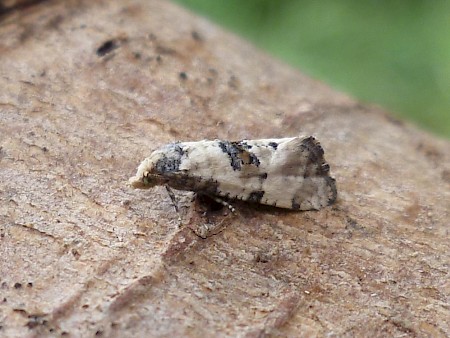49.14 BF967
Sheep's-bit Conch Cochylis pallidana
Zeller, 1847
Wingspan 10–14 mm.
This modest looking moth gets its common name from the plant its larvae feed on.
In June and July, adults come to the soft blue flower-heads of sheep’s-bit (Jasione montana) to lay their eggs. The larvae that emerge are distinguished by their brown heads, greenish-pink bodies, and pale yellow undersides. They feed on the seeds of the plant from July until as late as September. Then, spinning a cocoon under the leaf-litter below, they hibernate until April.
Adult moths are characterised by the white ground colour on their forewings, which is slightly stained here and there with small buff patches. This white colouration sets members of this species apart from their ochre-hued cousin, C. nana. Extending from the front edge of the Sheep-bit Conch’s forewing is another signature of this species: a narrow dark streak, which curves towards the outer margin. Fine black stripes border the front edge of the forewing, while a black botch, mottled with red-brown and grey scales, sits further down at each wing’s centre. The hindwings are pale brown.
Considered scarce in the British Isles, small populations of this species can be found in England, Wales, Ireland and parts of southern Scotland. The Sheep’s-bit Conch seems to prefer coastal areas, frequenting well drained grassland and sand dunes where its food plant grows. It rests during the day and flies freely at dusk.
Description: Michela Sisti

 UKMoths
UKMoths 


